Published: March 5, 2020
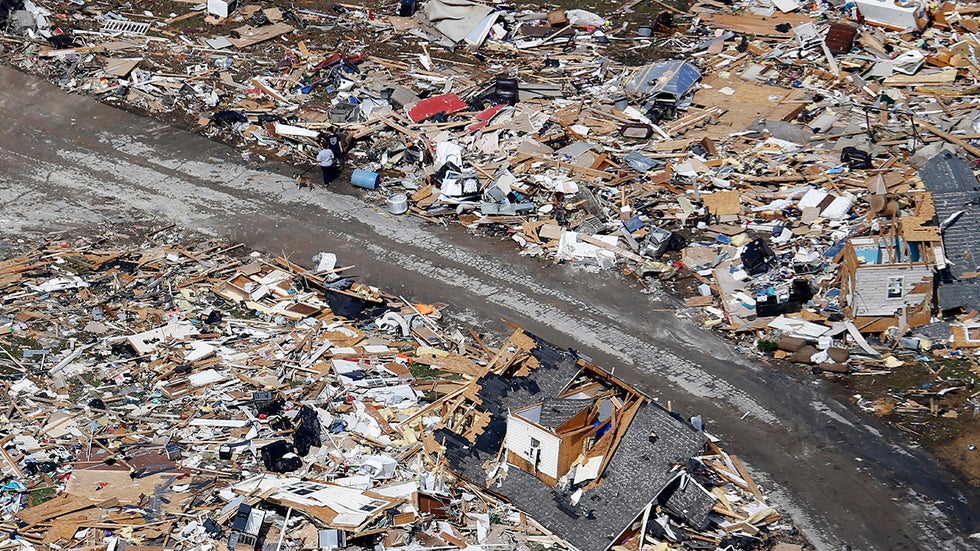 A road separates properties filled with debris Tuesday, March 3, 2020, near Lebanon, Tennessee.
A road separates properties filled with debris Tuesday, March 3, 2020, near Lebanon, Tennessee.
The most violent tornadoes make up a tiny fraction of all U.S. twisters, but they have claimed the most lives since 1950, according to government statistics.
While all tornadoes are capable of damage, meteorologists use the term "violent tornadoes" to refer to those rated EF4 or EF5, the highest two ratings on the Enhanced-Fujita scale. One such tornado in Putnam County, Tennessee, on March 3 was rated EF4.
The death toll from these 113 violent tornadoes (741 lives) exceeded the death toll from the other 24,442 tornadoes combined (727 lives). Put another way, each F/EF4 tornado killed an average of four people, while F/EF5 tornadoes killed an average of 37.
These most intense tornadoes – with estimated winds of 166 mph or more – are capable of devastating damage: tossing and crushing vehicles, leveling well-constructed homes and even sweeping foundations clean. (Note: The Fujita (F) scale was replaced by the Enhanced Fujita (EF) scale in February 2007. Wind speeds associated with each category were reduced, but the general type of damage expected was not changed.)
From 2000 to 2019, violent tornadoes were responsible for roughly half of all U.S. tornado deaths, according to data from NOAA's Storm Prediction Center.
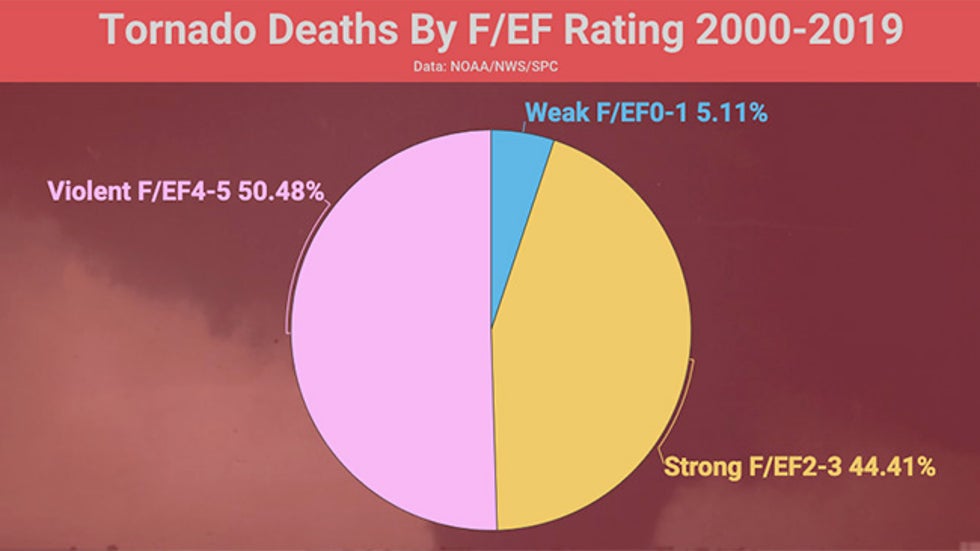 Violent (EF4 or EF5) tornadoes were responsible for half the tornado-related deaths in the U.S. from 2000 to 2019.
Violent (EF4 or EF5) tornadoes were responsible for half the tornado-related deaths in the U.S. from 2000 to 2019.
But these tornadoes are relatively rare. In that same 20-year period, violent tornadoes made up less than 0.5% of the nation's tornadoes.
Almost 90% of tornadoes from 2000 to 2019 were weak – rated F/EF0 or F/EF1 – but they're still capable of light to moderate damage to trees and homes, and significant damage to mobile homes.
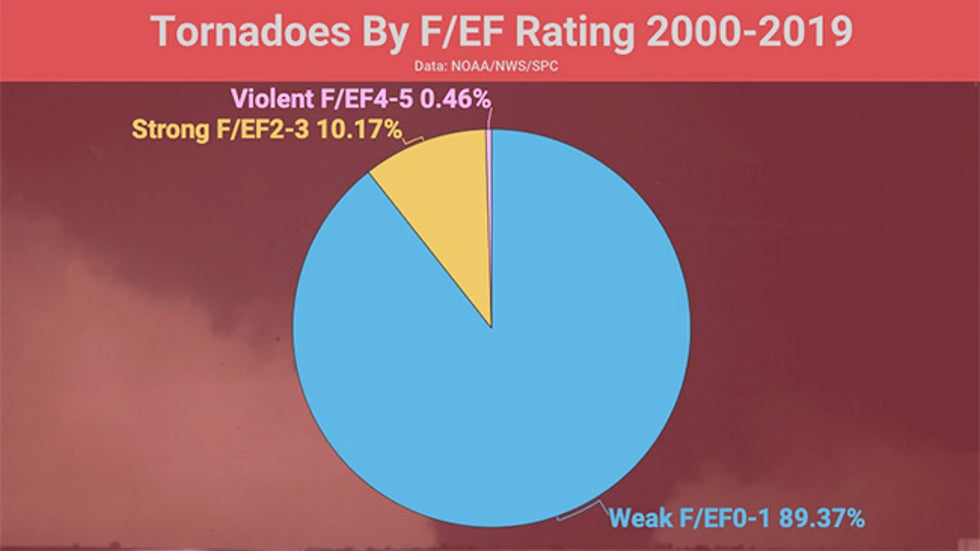 Violent (EF4 or EF5) tornadoes made up less than 0.5% of all tornadoes in the U.S. from 2000 to 2019. (Note: The 2019 U.S. tornado tally was still preliminary, as of the time of this article.)
Violent (EF4 or EF5) tornadoes made up less than 0.5% of all tornadoes in the U.S. from 2000 to 2019. (Note: The 2019 U.S. tornado tally was still preliminary, as of the time of this article.)
Since 1950, the U.S. has averaged nine violent tornadoes per year, according to NOAA.
Some years have few, if any, violent tornadoes.
There were three violent tornadoes in 2019 – Lee County, Alabama, on March 3; Montgomery County, Ohio, on May 27; and Leavenworth County, Kansas, on May 28 – all rated EF4.
In 2018, there were no EF4 or EF5 tornadoes anywhere in the U.S., the only year without a single violent tornado dating to 1950.
There hasn't been an EF5 in the U.S. since the Oklahoma City/Moore tornado on May 20, 2013.
Other years have had higher violent tornado counts, typically in larger outbreaks, which we'll highlight below.
Spring Is Peak Time of Year
We examined the 631 violent tornadoes in NOAA's database from 1950 through 2019 to see if there was a peak time of year.
We found a broad peak from April through early June, during which 61% of violent tornadoes occurred.
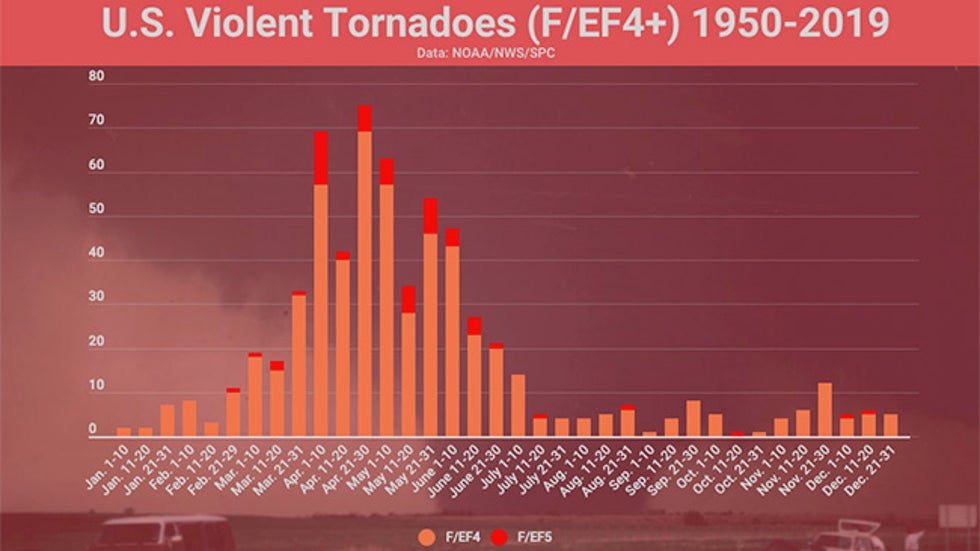 Timeline of violent U.S. tornadoes from 1950 through 2019, illustrating the general spring peak in these intense tornadoes.
Timeline of violent U.S. tornadoes from 1950 through 2019, illustrating the general spring peak in these intense tornadoes.
Multiple violent tornadoes can often cluster in higher-end outbreaks, accounting for some of this spring peak. Among these historic outbreaks include:
- April 2011 Super Outbreak: 15 violent tornadoes on April 27 alone, including four rated EF5
- May 3, 1999, Plains Outbreak: First F5 on record to hit Oklahoma City metro; F4 strikes southern side of Wichita, Kansas
- April 1974 Super Outbreak: 30 violent tornadoes, including six rated F5
- April 1965 Palm Sunday Outbreak: 22 violent tornadoes
 The remains of a Ford Explorer in Smithville, Mississippi, after an April 27, 2011, tornado.
The remains of a Ford Explorer in Smithville, Mississippi, after an April 27, 2011, tornado.
Spring typically provides a prime overlap of ingredients in the southern and central U.S. needed to generate the intense, rotating supercell thunderstorms that can spawn violent tornadoes.
Increasingly warm, humid air streaming northward out of the Gulf of Mexico is topped by cold, dry air aloft and a powerful jet stream pivoting out of the West. This provides the instability needed to generate thunderstorms.
In these cases, wind shear – the change in wind speed and direction with height – is intense. This allows supercells to form and provides the spin needed to stretch and tilt into tornadoes.
 An example of a prime setup for severe thunderstorms in the Plains states, particularly in spring.
An example of a prime setup for severe thunderstorms in the Plains states, particularly in spring.
Violent tornadoes are much less common from midsummer through fall and winter, but they can happen any time of year if the volatile setup is in place. They have occurred in every month, including winter.
For example, Christmas Eve F4 tornadoes tore through parts of Arkansas and Missouri in 1982 and Tennessee in 1988.
Top Violent Tornado States
It should come as no surprise where violent tornadoes occur most often.
In the 70-year period from 1950 to 2019, the conventional Plains "Tornado Alley" states of Oklahoma, Texas, Iowa and Kansas had the biggest number of violent tornadoes.
Elevated violent tornado counts also extend eastward into the Ohio Valley and a southern corridor known as "Dixie Alley," including Alabama, Mississippi and Tennessee.
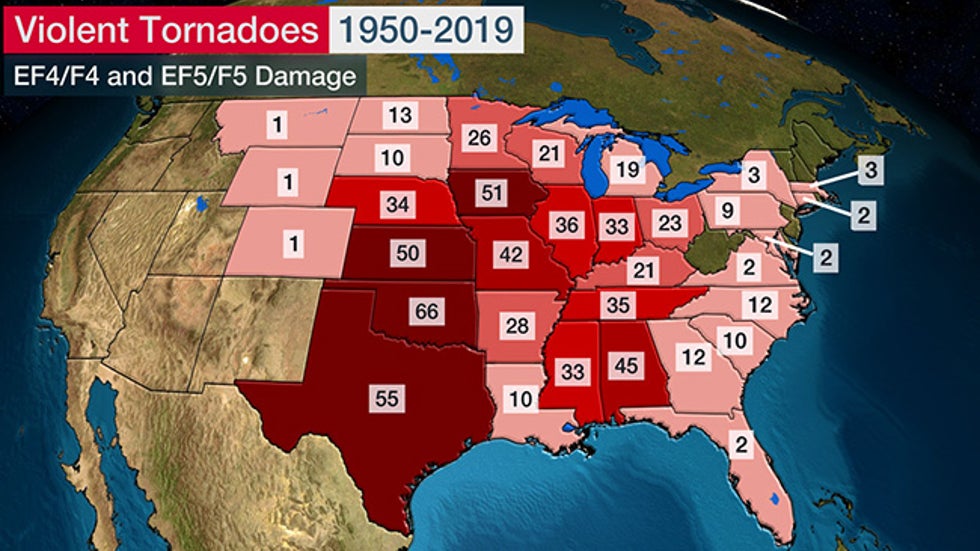 The number of violent (F/EF4 and F/EF5) tornadoes per state from 1950 to 2019.
The number of violent (F/EF4 and F/EF5) tornadoes per state from 1950 to 2019.
Damage from at least one violent tornado has been observed in 33 of 50 states.
Violent tornadoes are less common east of the Appalachians but have occurred as far north as Massachusetts and upstate New York and as far south as Florida.
Just one violent tornado has been documented from the Rockies to the West Coast.
On July 21, 1987, an F4 tornado reportedly uprooted a million trees as it ripped a path across the Teton and Yellowstone areas of northwestern Wyoming. The tornado affected elevations between 8,500 and 10,000 feet, making it the highest altitude that a violent tornado has been documented.
The Weather Company’s primary journalistic mission is to report on breaking weather news, the environment and the importance of science to our lives. This story does not necessarily represent the position of our parent company, IBM.
The Weather Company’s primary journalistic mission is to report on breaking weather news, the environment and the importance of science to our lives. This story does not necessarily represent the position of our parent company, IBM.

No comments:
Post a Comment